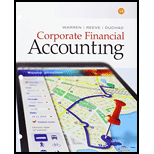
Bond investment: Bond investments are debt securities which pay a fixed interest revenue to the investor.
Debit and credit rules:
- Debit an increase in asset account, increase in expense account, decrease in liability account, and decrease in
stockholders’ equity accounts. - Credit decrease in asset account, increase in revenue account, increase in liability account, and increase in stockholders’ equity accounts.
To journalize: The bond investment transactions of S Products.
Explanation of Solution
(a)
Prepare journal entry for purchase of $120,000, 5% bonds of I Incorporation at 100% with an accrued interest of $1,000.
| Date | Account Titles and Explanations | Post. Ref. | Debit ($) | Credit ($) | |
| Investments–I Incorporation | 120,000 | ||||
| Interest Receivable | 1,000 | ||||
| Cash | 121,000 | ||||
| (To record purchase of M City bonds for cash) | |||||
Table (1)
- Investments–I Incorporation is an asset account. Since bonds investments are purchased, asset value increased, and an increase in asset is debited.
- Interest Receivable is an asset account. Since interest to be received has increased, asset value increased, and an increase in asset is debited.
- Cash is an asset account. Since cash is paid, asset account decreased, and a decrease in asset is credited.
(b)
Prepare journal entry to record the interest revenue received.
| Date | Account Titles and Explanations | Post. Ref. | Debit ($) | Credit ($) | |
| Cash | 3,000 | ||||
| Interest Receivable | 1,000 | ||||
| Interest Revenue | 1,000 | ||||
| (To record receipt of interest revenue) | |||||
Table (2)
- Cash is an asset account. Since cash is received, asset account increased, and an increase in asset is debited.
- Interest Receivable is an asset account. Since interest to be received is received, asset value decreased, and a decrease in asset is credited.
- Interest Revenue is a revenue account. Since revenues increase equity, equity value is increased, and an increase in equity is credited.
Working Notes:
Compute amount of interest received from I Incorporation.
(c)
Prepare journal entry for $60,000 bonds of I International sold at 101%, with an accrued interest of $100.
| Date | Account Titles and Explanations | Post. Ref. | Debit ($) | Credit ($) | |
| Cash | 61,100 | ||||
| Interest Revenue | 500 | ||||
| Gain on Sale of Investments | 600 | ||||
| Investments–I Incorporation | 60,000 | ||||
| (To record sale of I Incorporation bonds) | |||||
Table (3)
- Cash is an asset account. Since cash is received, asset account increased, and an increase in asset is debited.
- Interest Revenue is a revenue account. Since revenues increase equity, equity value is increased, and an increase in equity is credited.
- Gain on Sale of Investments is a revenue account. Since revenues increase equity, equity value is increased, and an increase in equity is credited.
- Investments–I Incorporation is an asset account. Since bond investments are sold, asset value decreased, and a decrease in asset is credited.
Working Notes:
Calculate the cash received from the sale of bonds.
| Particulars | Amount ($) |
| Cash proceeds from sale of $60,000 bonds
|
60,600 |
| Add: Accrued interest revenue | 500 |
| Cash received | $61,100 |
Table (4)
Calculate the realized gain (loss) on sale of $60,000 bonds.
| Particulars | Amount ($) |
| Cash proceeds from sale of $60,000 bonds
|
60,600 |
| Cost of bonds sold | (60,000) |
| Gain (loss) on sale of bonds | $600 |
Table (5)
Want to see more full solutions like this?
Chapter D Solutions
Bundle: Corporate Financial Accounting, Loose-leaf Version, 14th + CengageNOWv2, 1 term Printed Access Card
- Martinez Company plans to sell 8,500 orange beach umbrellas during May, 6,800 in June, and 8,500 during July. The company keeps 16.75% of the next month's sales as ending inventory. How many units should Martinez produce during June? (Rounding to whole units since you can't produce partial umbrellas). a. 5,374 b. 6,200 c. 7,157 d. Not enough information to determine.arrow_forwardNo WRONG ANSWERarrow_forwardSolve question and accounting questionarrow_forward
- Principles of Accounting Volume 1AccountingISBN:9781947172685Author:OpenStaxPublisher:OpenStax College
 Intermediate Accounting: Reporting And AnalysisAccountingISBN:9781337788281Author:James M. Wahlen, Jefferson P. Jones, Donald PagachPublisher:Cengage Learning
Intermediate Accounting: Reporting And AnalysisAccountingISBN:9781337788281Author:James M. Wahlen, Jefferson P. Jones, Donald PagachPublisher:Cengage Learning

